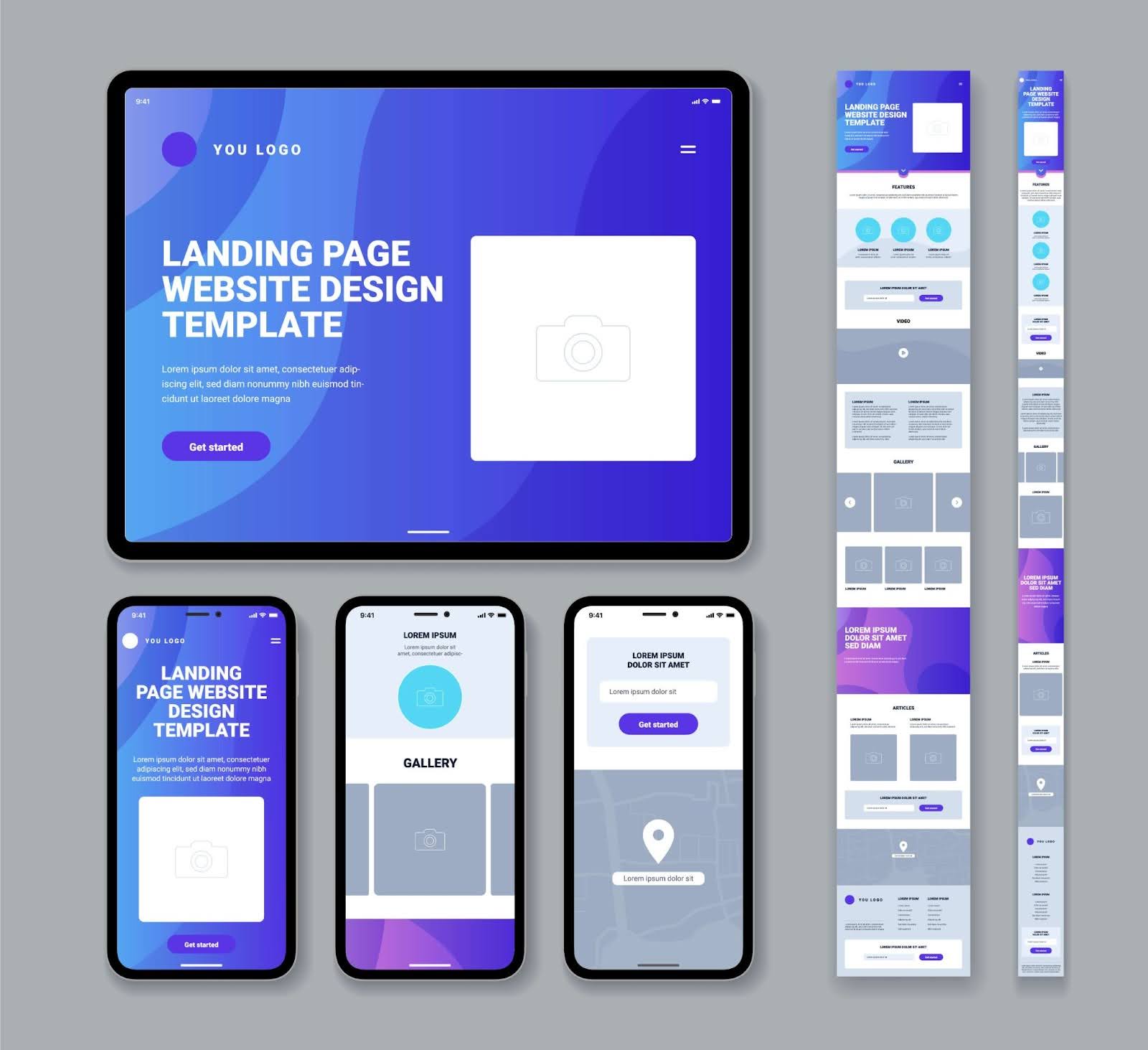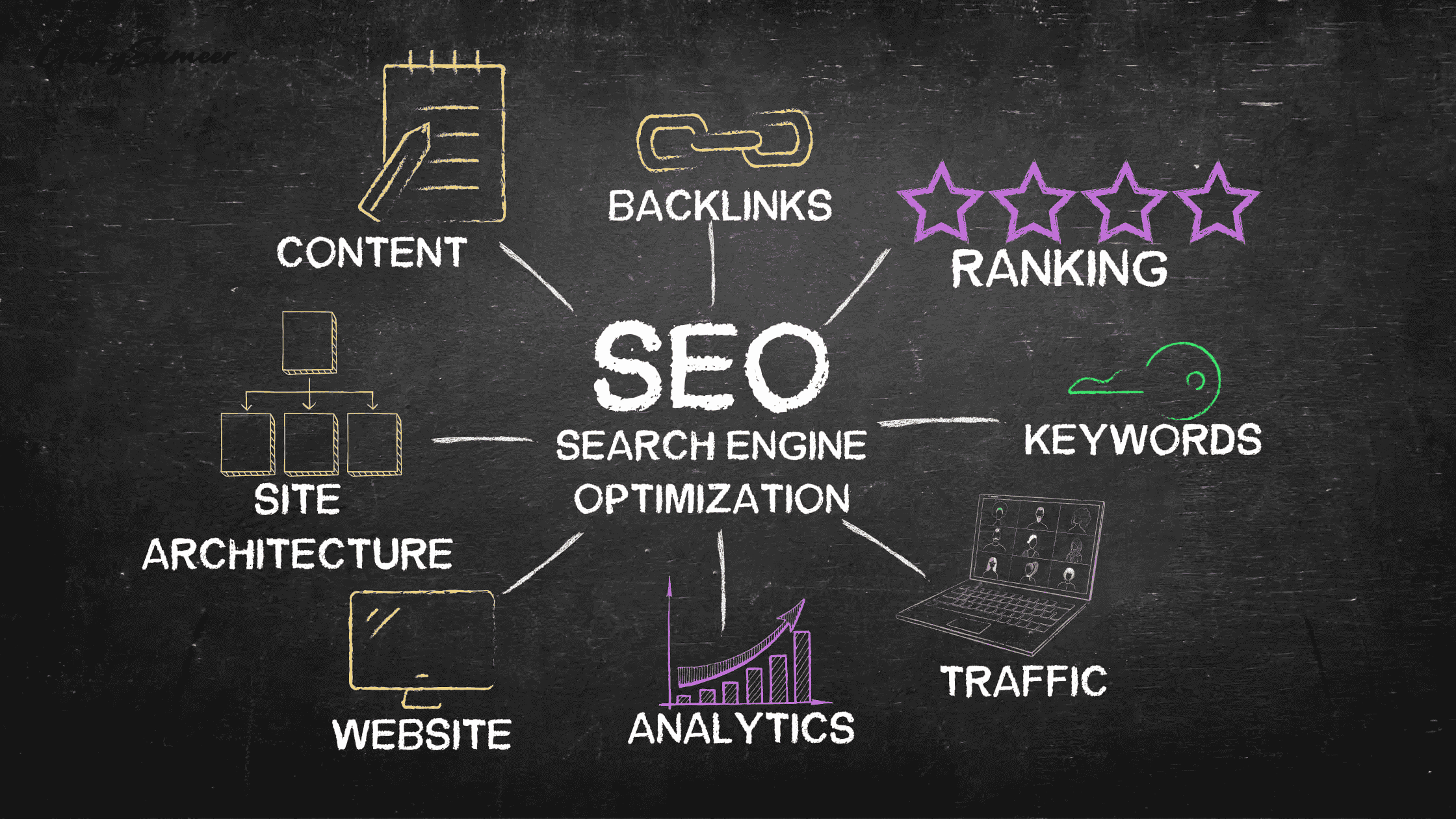How to Identify and Fill Content Gaps in Your Website
Creating content is no longer just about hitting publish, it’s about hitting the mark. In today’s constantly shifting online environment, even the most well-written content can fall flat if it doesn’t address what your audience is truly searching for.
That’s where content gap analysis becomes your secret weapon. Content gap analysis is the process of finding missing topics, keywords, or questions that your website doesn’t address yet — but your audience is searching for.
By uncovering the topics, keywords, and questions your content is missing, you can fill the gap between what you’re offering and what your audience actually needs. The result? Better SEO, more traffic, and a content strategy that actually delivers.
In this blog, we’ll show you how to identify content gaps, why they matter, and how to turn them into opportunities for growth. Let’s get started!
What is Content Gap?
A content gap is very important for content marketing, it refers to the missing information, topics, or keywords on your website that your audience is actively searching for but cannot find. It represents the difference between what users expect to find and what your content currently offers.
Acknowledging content gaps is a must because ignoring them can cause you to lose valuable traffic, you will be behind your competitors, and leave your audience's questions unanswered.
When you recognize and address these gaps, you not only improve your SEO performance but also create a better user experience.
Filling these gaps helps establish your brand as a trusted authority, increases engagement, and makes sure that your content fully supports the buyer’s journey from start to finish.

Types of Content Gaps
Content gaps are areas where your content is lacking compared to audience needs or competitors. Identifying these gaps helps improve SEO, engagement, and overall content performance.
a. Keyword Gaps
These occur when competitors rank for valuable keywords that your content misses. Targeting these keywords helps you attract more relevant traffic.
Use tools like Ahrefs or SEMrush to spot and prioritize these gaps.
b. Content Depth Gaps
Shallow content that lacks depth, examples, or data doesn’t perform well. Users expect detailed, helpful resources that answer all their questions. Expand your content with FAQs, statistics, case studies, and internal links.
c. Format Gaps
Sticking only to blog posts or articles limits how users engage with your content. Different users prefer different formats— training videos, infographics, podcasts, etc. Using varied formats improves engagement and helps reach wider audiences.
d. Audience Gaps
Your content may focus on one audience type while ignoring others (e.g., beginners, SMBs, or specific industries). This limits your growth potential. Creating tailored content for each persona helps drive more targeted conversions.
e. Intent Gaps
If your content doesn’t align with what users intend to do (research, compare, buy), they’ll bounce. Understanding search intent—informational, navigational, or transactional—is key to ranking and converting.
f. Update Gaps
Old, outdated posts lose SEO value and credibility. Users want the latest information, especially in fast-changing industries. Regularly update stats, screenshots, tools, and examples to keep your content fresh and competitive.
g. Media Gaps
Content without visuals, screenshots, or videos can feel dull and less informative. Using an AI photo editor can help you create eye-catching images that make your content more engaging and easier to understand.
Media elements help explain complex topics and improve user experience. Adding engaging media also boosts SEO, shareability, and dwell time.
Why is Content Important for SEO?
Content is the foundation of any successful SEO strategy because it helps search engines understand the relevance and value of your website. Without content, there’s nothing for Google to crawl, index, or rank.
A SEO AI Agent can help create High-quality, keyword-optimized content that allows you to target the specific search terms your audience is using, increasing your chances of appearing in search results.
It also helps answer user intent, whether someone is looking for information, making a comparison, or ready to buy ensuring your content meets their needs and keeps them engaged.
Moreover, valuable and original content attracts backlinks from other reputable websites, which significantly boosts your domain authority and trust in the eyes of search engines.
When users find your content helpful, they spend more time on your site, reducing bounce rates and sending positive engagement signals to Google.
Content also enables better internal linking, improving site structure and helping search engines crawl your site more efficiently.
Strong content is not just about ranking it’s about providing value, building trust, and guiding users toward taking action. Without it, even the most technically optimized website will struggle to perform well in search.
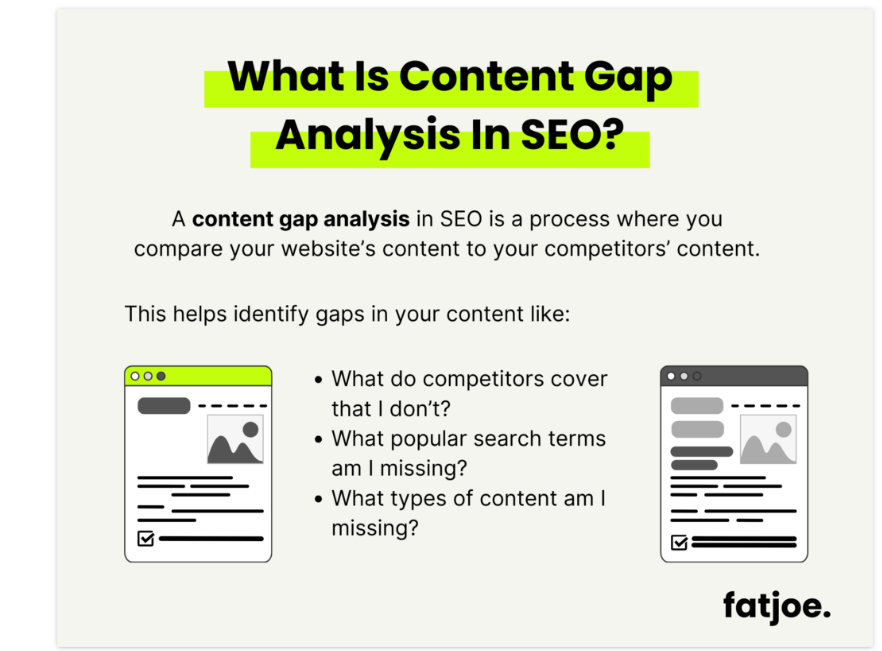
Why Perform Content Gap Analysis?
Content gap analysis helps identify missing or underrepresented topics in existing content, making sure you meet your audience’s needs. It improves SEO, enhances user engagement, and drives better content strategy decisions.
1. To Improve SEO Rankings
Content gap analysis helps identify valuable keywords, questions, and topics that your site currently doesn’t cover but your competitors do. These gaps may be the reason you're not ranking well for certain search terms or losing potential traffic to rival websites.
By filling these content voids with optimized, high-quality articles, blog posts, or landing pages, you increase your SEO ranking on Google. This not only boosts visibility but also helps capture untapped segments of your target audience and significantly improve your SEO performance.
2. To Enhance User Journey
Content Content gaps often lead to broken or incomplete user experiences, where visitors come to your site but leave without finding the answers or next steps they’re looking for. This can hurt your engagement metrics and reduce the chances of conversion.
By identifying and filling these gaps, you ensure a more seamless and satisfying journey—guiding users from awareness to consideration to decision-making. When your content anticipates user needs at every stage, it builds trust, increases time on site, and improves the likelihood of turning visitors into loyal customers.
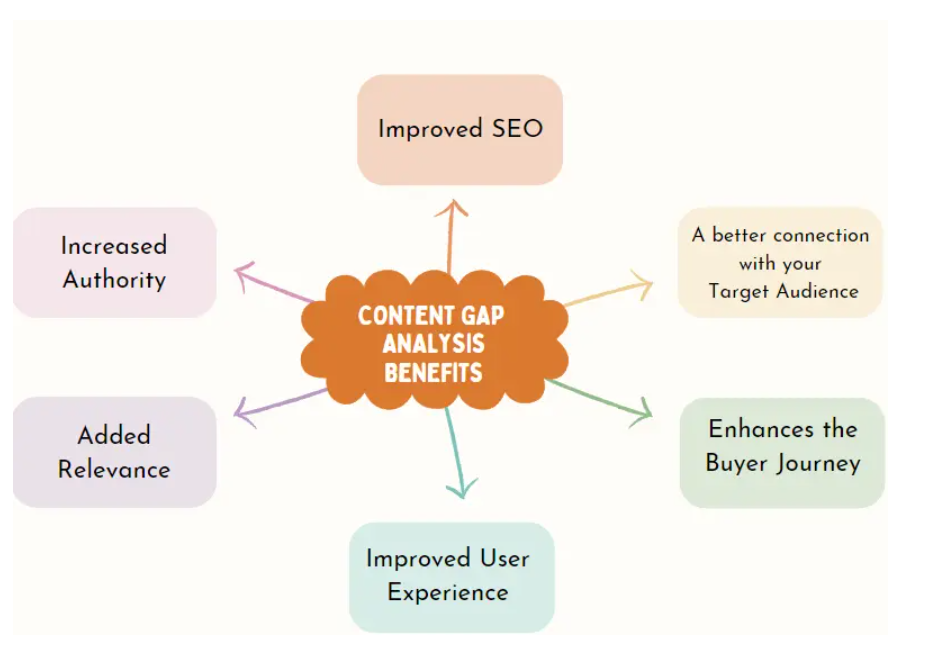
3. To Maximize Content ROI
Content creation takes time, effort, and budget—so making every piece count is essential. Content gap analysis eliminates the guesswork by showing you exactly what your audience is searching for and where your competitors are outperforming you.
This allows you to focus your resources on high-impact topics that fill those gaps and drive measurable results. By creating strategic, data-driven content instead of publishing blindly, you increase engagement, leads, and conversions—ultimately maximizing the return on your content investment.
Steps To Do Content Gap Analysis
Content gap analysis is a powerful strategy that helps you find missing opportunities in your content. When you consistently fill these gaps, you can boost your website authority, improve SEO rankings, and offer more value to your users.
a. Find Competitors’ Keywords
Use SEO tools like Ahrefs, SEMrush, or Ubersuggest to discover which keywords your competitors are ranking for but you’re not. This helps uncover valuable search terms and topics you may have missed. Focus on keywords with high search volume and low to medium competition for quicker wins.
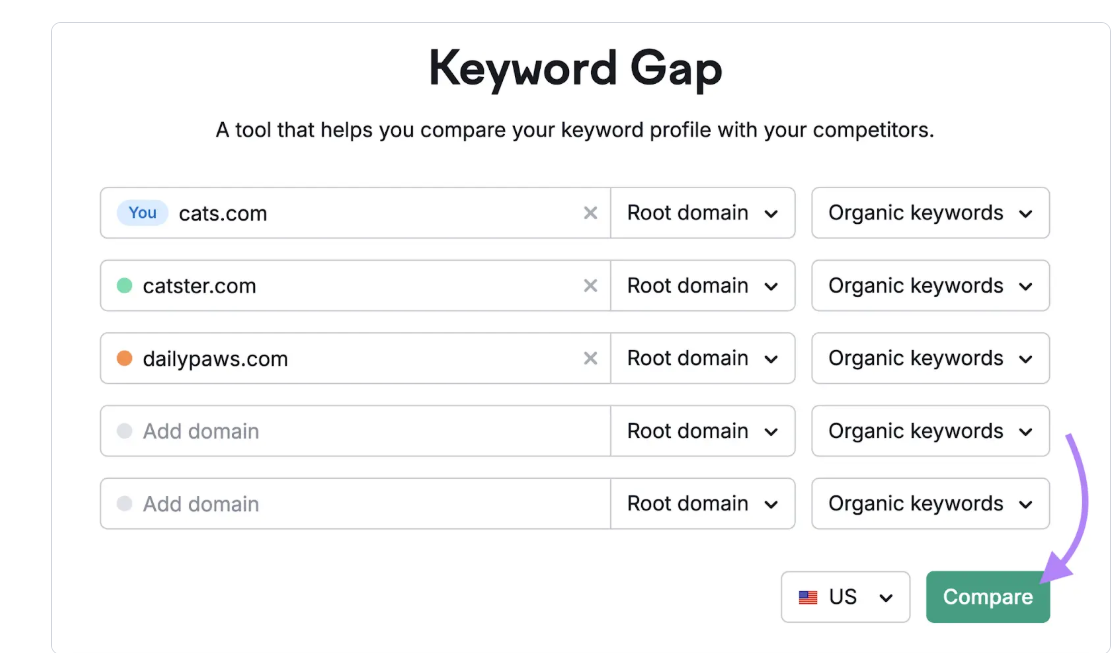
How to find competitors’ keywords:
- Use tools like Ahrefs, SEMrush, or Ubersuggest to enter your domain and compare it with your competitors.
- Look for the “Content Gap” or “Keyword Gap” tool to see side-by-side comparisons.
- Filter for keywords where your competitors rank in the top 10 and your site doesn't rank at all.
- Focus on keywords that have high search volume and low-to-medium competition for the best opportunities.
- Check what type of content is ranking for those keywords — blog posts, guides, product pages, etc.
b. Set Clear Objectives
Start by defining what you want to achieve with your content gap analysis. Whether it’s to increase search traffic, improve conversions, or rank for new keywords, having clear goals will guide your research and prioritization. Clear objectives also help measure the success of your efforts and align your content strategy with business goals.
Goals can include:
- Increasing organic traffic to specific pages
- Ranking higher than competitors for targeted keywords
- Covering more stages of the buyer’s journey
- Improving topical authority in your niche
c. Audit Your Existing Content

Conduct a full content audit to see what topics and keywords you’re already covering, and where your strengths and weaknesses lie. This gives you a baseline before identifying gaps.
Use SEO tools like Google Search Console or Screaming Frog to analyze performance, and categorize content by topic, format, and target intent.
Things to evaluate:
- Pages that get the most and least traffic
- Content that is outdated or underperforming
- Duplicate or thin content
- Keyword targets and current rankings
Tools to use:
- Google Analytics
- Google Search Console
- Screaming Frog SEO Spider
d. Understand Your Audience’s Needs
To create meaningful and relevant content, you must first understand what your audience truly wants. Dive into their pain points, questions, and search behavior to uncover the gaps in your current content strategy.
Also, while researching your target audience, tools that help you understand online behavior or even how to find phone numbers for outreach can assist in audience segmentation and direct marketing strategies.
For example, if you’re building content for businesses looking to automate billing, understanding how recurring payments work can help you tailor your messaging to their specific pain points and search intent.
Ways to research audience needs:
- Analyze customer queries from emails or support tickets
- Use forums like Reddit, Quora, and niche Facebook groups
- Explore “People Also Ask” boxes on Google
- Use tools like AnswerThePublic or AlsoAsked
e. Analyze SERPs (Search Engine Results Pages)
Reviewing the current SERPs for your target keywords gives you valuable insights into what Google is favoring and what types of content dominate the rankings. It also shows gaps in your approach.
What to look for in SERPs:
- Featured snippets, People Also Ask, or video results
- The structure of top-ranking content (length, format, headings)
- Search intent behind the results (informational, transactional, etc.)
- Common content themes competitors are using

f. Research Competitor Content
Analyzing your competitors’ content is a key step in identifying gaps and uncovering opportunities. Look at what topics, keywords, and formats they are covering, and evaluate how well their content performs in terms of engagement, shares, and rankings.
Use tools like:
- Ahrefs (Content Gap tool)
- SEMrush (Keyword Gap tool)
- Ubersuggest
- BuzzSumo
What to analyze:
- Keywords your competitors rank for but you don’t
- Popular topics and themes they’ve covered
- Content depth and value provided
- Content formats they use effectively
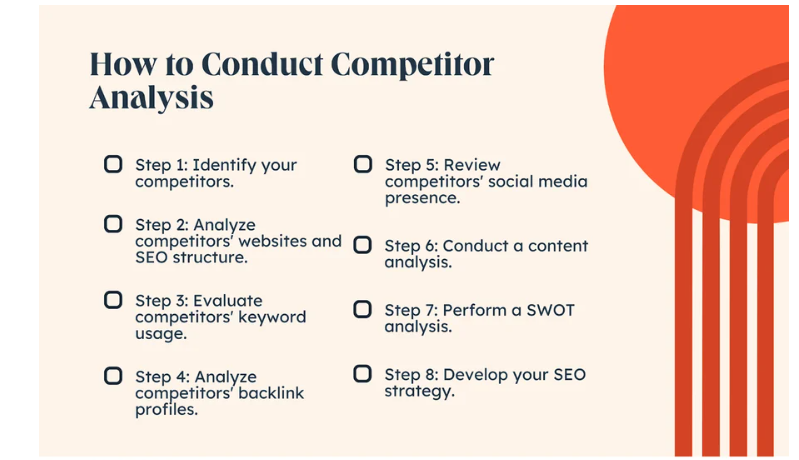
g. Identify the Content Gaps
Now, bring everything together to pinpoint the actual gaps in your content. Focus on what your audience is searching for, what your competitors are covering, and what your current content is missing.
Types of gaps to identify:
- Missing keywords or topics
- Incomplete coverage of a subject
- Skipped stages in the buyer journey
- Unused content formats (video, FAQ, infographics)
Prioritize based on:
- Search volume and traffic potential
- Keyword difficulty
- Relevance to your audience
- Business impact
h. Plan Content to Fill the Gaps
After identifying content gaps, create a strategy to address them by focusing on high-priority topics that align with your goals. Use a content calendar to prioritize and plan different formats (blogs, videos, etc.) to meet audience needs. Ensure your content is comprehensive, unique, and adds value. This improves engagement and drives more traffic.
Key parts of your plan:
- Content types (blog posts, guides, videos, etc.)
- Target keywords and intent
- Content structure and format
- Publishing schedule and deadlines
i. Optimize and Update Existing Content
Instead of always starting from scratch, look for ways to enhance your current content. Updating underperforming articles can be a quicker path to SEO improvement than creating new ones.
Ways to optimize:
- Add missing sections or keywords
- Improve readability and structure
- Refresh outdated facts and links
- Optimize headings and meta descriptions
j. Track Performance and Repeat Regularly

Once your new and updated content is live, it’s important to track performance and measure the impact. Content gap analysis should be an ongoing practice, not a one-time task.
How to monitor results:
- Track keyword ranking changes
- Monitor traffic growth and bounce rates
- Use tools like Google Analytics, Search Console, Ahrefs
- Schedule content audits every 6 to 12 months
3 Best Tools to Perform Content Gap Analysis
The best tools for content gap analysis help identify keyword opportunities and optimize content for better search engine rankings. Tools like SEMrush, Ahrefs, and Ubersuggest provide detailed insights into competitor content and highlight gaps in your own strategy.
1. Ahrefs

Ahrefs is a powerful SEO tool widely used for competitor research, backlink analysis, and keyword tracking. Its Content Gap Tool lets you compare your website with competitors to find keywords they rank for — but you don’t.
Key Features:
- Discover missing keywords with side-by-side domain comparisons
- Filter results by search volume and keyword difficulty
- Analyze multiple competitors at once
Perfect for: Finding high-impact keyword opportunities and uncovering untapped topics.
2. SEMrush
 SEMrush is a comprehensive digital marketing platform offering tools for SEO, PPC, content, and social media. Its Keyword Gap Tool is ideal for comparing keyword profiles across up to five domains.
SEMrush is a comprehensive digital marketing platform offering tools for SEO, PPC, content, and social media. Its Keyword Gap Tool is ideal for comparing keyword profiles across up to five domains.
Key Features:
- Easily spot shared, missing, and unique keywords
- Compare both organic and paid keywords
- Visual graphs for quick insights
Perfect for: Marketers who want an in-depth look at how their keyword strategy stacks up to competitors.
3. Ubersuggest

Ubersuggest, created by Neil Patel, is a beginner-friendly SEO tool that combines simplicity with useful data. It helps you find content gaps and keyword opportunities with less complexity than other tools.
Key Features:
- See keywords your competitors rank for that you don’t
- View content ideas and top-performing pages
- Get keyword suggestions with volume and difficulty scores
FAQ’S (Frequently Asked Questions)
Q1. How often should I do a content gap analysis?
A. Ideally, you should perform a content gap analysis every 6-12 months or after major industry changes. It keeps your content strategy fresh and aligned with audience needs.
Q2. What tools are best for content gap analysis?
A. Popular tools include Ahrefs, SEMrush, Ubersuggest, Google Search Console, and BuzzSumo. They help you find keyword gaps, content gaps, and competitor insights easily.
Q3. Can I do a content gap analysis manually without tools?
A. Yes, you can! It takes more time, but you can manually review competitor websites, search popular industry forums, and use Google’s "People also ask" sections for ideas.
Q4. Should I update old content or create new content first?
A. It depends. If your old content is still relevant but missing important information, update it first. If you’re missing major topics entirely, prioritize creating new content.
Q5. Is content gap analysis only for blogs?
A. No. It applies to all types of content — landing pages, FAQs, videos, ebooks, social media posts, and more. Wherever users seek information, content gaps can exist.
Conclusion
Content gap analysis is not just a one-time task — it's an essential, ongoing process if you want your content marketing to succeed. By understanding what your audience needs, analyzing your competition, and filling in those missing pieces, you ensure your content stays valuable, relevant, and competitive.
Whether you're aiming to grow traffic, boost engagement, or convert more customers, performing a strategic content gap analysis will give you the insights needed to drive better results.
Start today because the best opportunities often lie in the gaps you haven't explored yet!




